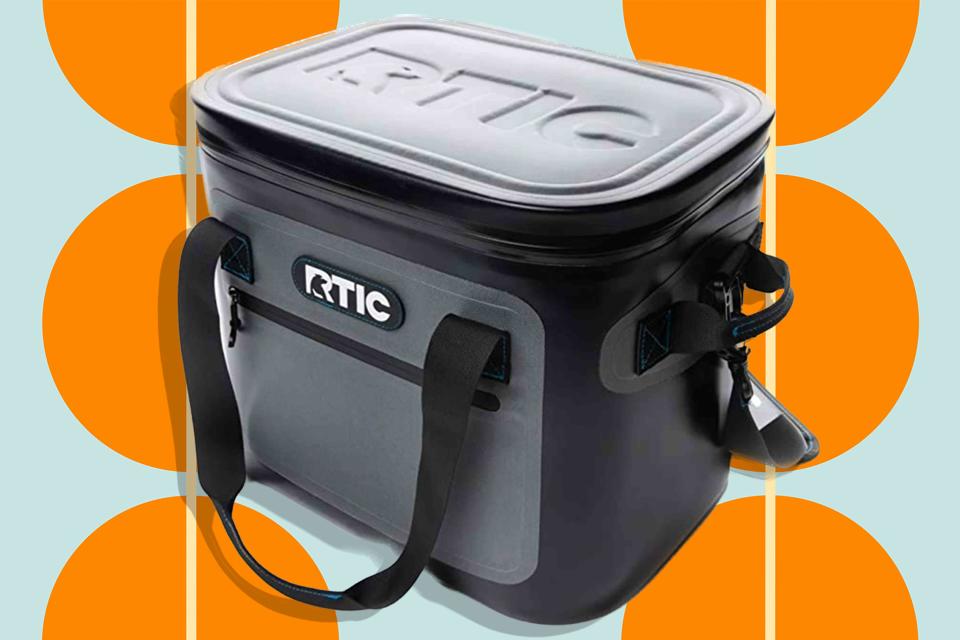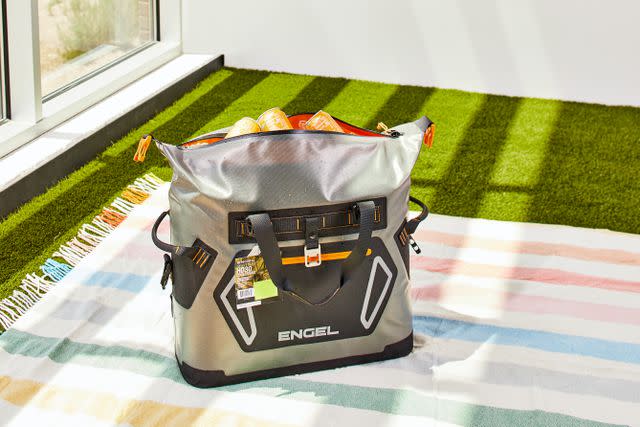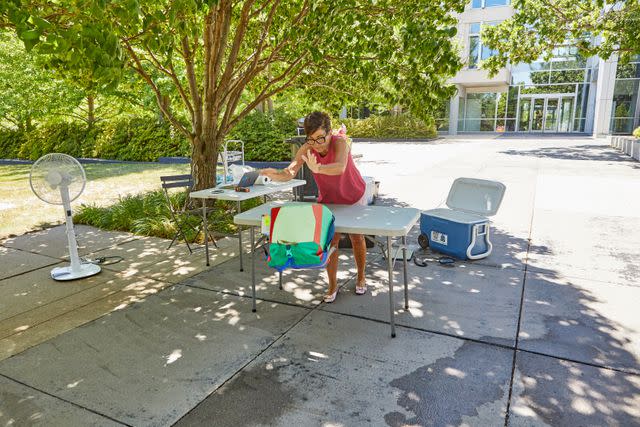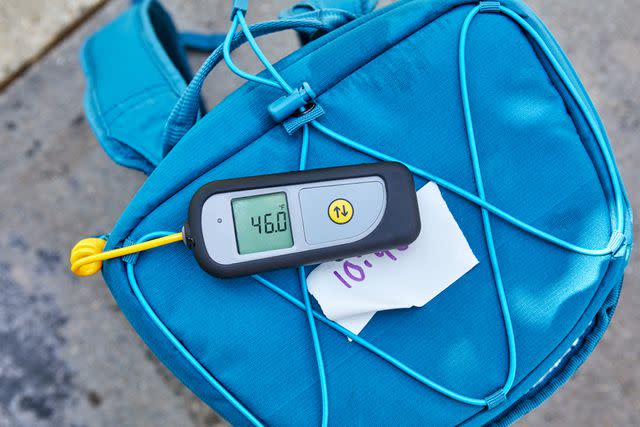We Tested and Found 5 Soft Coolers That Don’t Make Hauling Drinks a Chore
Dotdash Meredith and Yahoo Inc. may earn commission or revenue on some items through the links below.
Including totes, backpacks, and collapsible options.

Food&Wine/Maria DeAngelis
Whether it’s a short solo hike, a family beach trip, or a fishing excursion with friends, every adventure calls for a cooler packed with plenty of food and drink to fuel your body. Compared to hard coolers, soft coolers (or soft-sided coolers) are often lighter, more convenient to travel with, and easier to store. From compact designs to family-sized options, there’s one to suit everyone’s needs.
After testing soft coolers in our lab and then at home for six months, we determined our favorites based on factors like insulation, design, capacity, portability, and intended use. Keep scrolling to see which ones made our list and why they are worth the money.
Best Overall: RTIC Outdoors 30-Can Backpack

Pros
This colorful cooler is lightweight, durable, and easily portable — plus, it floats!
Cons
The zipper can be fussy.
Despite being a soft cooler, this one brings some extra durability with its structured outer shell. Under that, you have two inches of foam plus a puncture- and tear-resistant liner that keeps things insulated for up to 24 hours. One of the cooler’s best features is that it floats, so if you’re using it for a pool day or a lake vacation, it can stick right by your side. If it’s not floating around, you can either carry it with the sturdy handle straps or by slinging the longer strap over your shoulder. One drawback though is that you may find the zipper tricky to open and close.
We think the size that fits 30 cans offers a good balance of capacity and portability, but you can also get it in 12-, 20-, or 40-can sizes. The cooler also comes in various colors, from muted tones like bluish-gray and tan to vibrant options like citrus and coral.
Price at time of publish: $130
Capacity: 22 quarts
Size: 15.5 x 11.5 x 12.75 inches
Weight: 4 pounds
Best Value: Bluu Softside Leakproof Cooler Bag

Pros
This affordable choice has a large capacity and excellent insulation.
Cons
The bag can collapse or fall over if not packed sufficiently in the bottom.
The price tag is appealing on this value pick, but even more so considering that it has a capacity of 25 quarts and is designed to stay cool for up to five days thanks to an inch of insulation foam. After months of testing, we can attest to its superior insulation, keeping beverages cold all day long while tailgating and kayaking, and its spacious interior for storing cans, bottles, and food containers. That, along with the UV protective barrier on the waterproof exterior, makes it a great companion for day-long outings.
When adding your snacks and drinks, you’ll want to pack the bottom densely so that the bag can easily stand up on its own, as we found that it tends to tip over when the base is even. You have two options for carrying this soft cooler around: Hold it in one hand or wear it as a shoulder bag — the straps are padded for added comfort.
Price at time of publish: $70
Capacity: 25 quarts
Size: 17.5 x 10.4 x 13.8 inches
Weight: Not listed
Best Splurge: Engel HD30 Waterproof Soft-Sided Cooler Tote Bag

Pros
It’s leakproof, durable, comfortable to carry, and a suitable size for many activities.
Cons
Make sure to lubricate the zipper regularly and bring an extra bag since it doesn’t have functional outer pockets.
We were extremely impressed with this 30-quart cooler that fit 48 cans plus ice with no problem. When packing the cooler, keep in mind how far you have to walk with it. Carrying a large number of cans is always going to be more challenging than a small load, but, luckily, the sturdy handles and comfortable shoulder strap make trips as smooth as possible.
Our favorite parts of this cooler happen to be the most important functions of a cooler. It kept food and drinks cold over a weekend trip, and it didn’t have any issues with leakage. One thing to note is that due to its watertight design, the zipper can be tricky to open and close. To help it glide smoother, we recommend using a lubricant.
Price at time of publish: $240
Capacity: Fits 48 cans plus ice
Size: 20.5 x 9.5 x 17 inches
Weight: 5 pounds

Food & Wine / Dera Burreson
Best Backpack: Hydro Flask Escape Soft Cooler

Pros
This backpack cooler has a large capacity (roomy enough to fit multiple wine bottles) and keeps drinks cold for days.
Cons
It’s on the pricier side, and the zipper opening can be hard to stretch wide for larger items.
It doesn't get much more convenient than a backpack cooler. Instead of carrying all the weight on one shoulder or in your hands, you can toss it on your back and walk comfortably. It features padded straps, a cushioned back panel, and a chest strap, making you feel supported and balanced on long hikes and walks.
During our backpack cooler tests, we loved its leakproof seams, superior insulation, and sleek design. It's suitable for keeping bottles of white wine chilled for sunset picnics, a pack of beer or seltzers crisp for football tailgates, and bottles of water ice cold on hikes. There's also a dry pocket to stash a map, protein bars, or any other items you want to stay dry. The only con we have with this model is that the zipper opening can be hard to stretch, so larger items, such as food containers, might not fit.
Price at time of publish: $200
Capacity: 20 liters
Size: 8.47 x 18.52 x 18.12 inches
Weight: 2.63 pounds
Best Collapsible: IceMule Classic Insulated Backpack Cooler Bag

Pros
It’s a breeze to stow away this highly portable, floatable soft cooler.
Cons
You may be left wanting more from the super streamlined design.
This collapsible soft cooler keeps things simple. There are no extra frills here, so don’t expect any extra pockets or hooks; however, it features a padded cross-body strap, many color options, and hours of ice retention. It’s great for people with limited storage space or who are always traveling because you can roll it right up and stow it away when not in use. It’s also waterproof and floats (there’s a valve that adds air to the insulation layer), so feel free to carry it with you right into the lake or ocean.
Because the bag is designed with a top-roll closure, it can be difficult to reach drinks at the bottom when it’s full, so keep that in mind while packing. You’ll also want to be sure to properly roll the top closed to ensure there aren’t any leaks.
Price at time of publish: $75
Capacity: 10.6 quarts
Size: 9 x 9 x 18 inches
Weight: 1 pound
Related: The 7 Best Wine Fridges for Your Home
Our Favorite
The RTIC Soft Pack Cooler is our overall favorite because it has a good balance between portability, performance, and durability. If you’re searching for a backpack soft cooler, we recommend the Hydro Flask Escape Backpack Cooler for its thoughtful, stylish design and top-notch functionality.

Food & Wine / Henry Wortock
Our Soft Cooler Tests
We spent three days testing 48 coolers from top-rated brands like Coleman, Yeti, and RTIC. This included various types of coolers, including backpack coolers, wheeled designs, large hard coolers, and, of course, soft-sided ones. For this article, we separated the insights of soft coolers from the rest so we could compare alike models and determine which ones are worthy of our seal of approval.
When testing the coolers in our lab, we rated each one on a scale from one to five (with five being the highest) in six different categories: design, insulation, durability, portability, capacity, and value. To evaluate their design, we determined how hard or easy it was to open and close the zippers, noted bonus features like drainage plugs, and looked at the overall quality of the coolers. Next, we tested the cooler’s insulation by filling each one with one-third soda cans and two-thirds ice, recording the temperature right away, after two hours of sitting in the summer heat, and then again the next day.
For the durability test, we knocked each cooler off a table to see if it remained closed or leaked and whether it got any scratches or other signs of wear. Our portability test included carrying it around using the different straps and noting the ease of transport, comfort, and functionality. When testing the capacity, we checked to see if the cooler could fit more or fewer cans than the manufacturer claims. And finally, we rated each cooler’s value based on whether or not its performance aligns with its price.
Factors to Consider
Insulation
The type, number of layers, and efficacy of insulation differs among soft coolers. Even if you don’t know the technicalities of what kind of insulation to look for, you can check the manufacturer’s description for how long the cooler is supposed to retain ice or keep cool. Often, they will give you a time estimate in terms of hours or days, but keep in mind this can vary depending on what the contents are, how the cooler was packed, and what the weather is like outside. Remember, it’s okay if a soft cooler only keeps ice cool for 24 hours if you’re never planning on using it for multi-day trips.
Size and Capacity
Are you planning on using your soft cooler to take lunch to work, or are you thinking of carrying food and drinks for the whole family on a camping trip? Your intended usage will determine what size and capacity of a soft cooler to go for. Manufacturers may list capacity by quarts, liters, or simply the number of cans or amount of ice that can fit inside.
For an individual meal, 15 quarts or less works. For day trips, a 20- to 30-quart capacity cooler should be suitable depending on how many people you’re traveling with and what you’re packing. Once you’re in the 50-quart range and up, you’re in the large-capacity territory fit for longer adventures or big outdoor gatherings.
Intended Use
When shopping for a soft cooler, consider your intended use so you know what design best suits your needs. For example, if you want a soft cooler to take cold beverages with you on a hike, go for a backpack so you can stay hands-free, or a collapsible design so you can pack it away. If, on the other hand, you need a soft cooler to carry dozens of drinks for camping or tailgating, then a tote or a cooler with wheels might be your best bet. Always think about how much you might be moving with the soft cooler (and whether you’re on foot or using a vehicle), so your cooler doesn’t become a burden.

Food & Wine / henry wortock
Frequently Asked Questions
Should I get a soft-sided or a hard-sided cooler?
Both types of coolers are meant to keep what you put inside at a nice fresh temperature. Which one is best for you depends on how you’ll be using it. Soft coolers are often lighter than hard-sided ones, making them easier to tote around on a regular basis. Their soft, flexible material lends itself well to a sling or backpack design, which makes them even more portable, as well as collapsible designs, which makes them easy to store.
Hard coolers are more heavy-duty, meaning that they can stand up to harsher elements (weather and wildlife included). They’re typically made from hard plastic, and while that thickness certainly helps with insulation and cooling, it also means added weight.
How long do soft coolers stay cold?
Soft coolers come in many different designs, so you'll also find a range with how long each one stays cold. Some keep foods and beverages cool for 24 hours, while others maintain insulation for multiple days. It all depends on what kind of material the cooler is made out of and what type of insulation it has.
To keep your soft cooler cold for as long as possible, keep it closed tightly and limit how often you open it to look around, which allows warm air in. You can also load it with items that are already cold or frozen, rather than room temperature, and place it in the shade.
Can you put dry ice in soft coolers?
Throwing some ice into your soft cooler along with your drinks helps keep the temperature low, so you may think that putting in dry ice, which is colder than regular ice, would be even better. The thing is, many soft coolers are not compatible with dry ice because it can damage the cooler or pose a health risk.
If you do have a cooler that works with dry ice, there are certain safety precautions you need to follow. When dry ice melts, it turns into carbon dioxide gas, which can cause negative health effects, like causing someone to pass out, without enough ventilation. Always make sure the cooler is somewhere with sufficient ventilation. Not sure whether or not you can put dry ice in your soft cooler? Check the manufacturer’s instructions.
Other Soft Coolers We Tested
Strong Contenders
The Get Out Cooler Bag ($260 at The Get Out)
We loved its retro-inspired style, ability to fit wine bottles, comfortable straps, and leak-free design. The only caveats were its high price and a small front pocket that didn’t serve much of a purpose, as it couldn’t even fit a smartphone. All in all, it’s an excellent choice if you’re willing to spend more.
Herschel Insulated Pop Quiz Cooler 30 Pack ($100 at Herschel)
This cooler has functional storage compartments, ample room for a 24-pack of cans plus ice, and durable construction. It fell short in terms of insulation and security, as the ice melted fairly quickly and seeped through during the drop test.
REI Co-op Cool Haul 24 Soft Cooler ($130 at REI)
This cooler has a lot of perks, including a bottle opener, pockets on the front and back, a zipper pouch on the inside of the lid, a shoulder strap, carrying handles, and side handles. On the downside, it leaked right away when tipped on its side.
What Didn’t Make the List
The low performers of the bunch included soft coolers from Everlasting Comfort, Coleman, and Oyoest. We were most surprised by the Coleman Sportflex Backpack’s performance since we love other coolers from the brand. During our tests, it leaked when tipped on its side, and the material isn’t suitable for rain and wet conditions. Other common issues among these coolers included leakage, lack of insulation, uncomfortable straps, and small capacity.
Our Expertise
Cindy Brzostowski is a freelance writer and avid home cook who has previous experience in cookbook publishing. Her writing has been featured in Allrecipes, Blue Apron, The Kitchn, and EatingWell among other publications. For this article, she used insights from our in-house cooler test to determine the best soft coolers on the market.
For more Food & Wine news, make sure to sign up for our newsletter!
Read the original article on Food & Wine.

